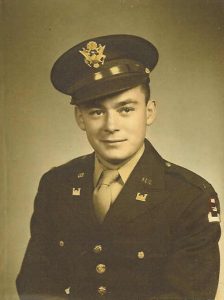Video tells the story of one South Carolinian on D-Day
May 22, 2019On June 6, 1944, Lt. James Richard Mooneyhan landed on the stretch of Norman shoreline code-named Dog Green – the same sector of Omaha Beach depicted in the harrowing opening minutes of “Saving Private Ryan.”
For most of the rest of his life, like so many soldiers who have been face-to-face with history, he didn’t talk about it. But before he passed away in 2011, he sat down with his daughter Barbara for a video interview.
Barbara Mooneyhan will present that video on Friday, June 7, at noon at the South Carolina Confederate Relic Room and Military Museum in Columbia. The free program, part of the museum’s Lunch and Learn series, is open to the public.
In the video, the veteran told the story common to so many of his generation – how he went from small-town life of Elliott, S.C., into the Army and eventually to England. There, as a platoon leader in the 502nd Engineers, a light ponton company, he trained on the rapid assembly of Bailey Bridges as well as other means of overcoming obstacles infantry would face in the invasion.
After their long months of training, Mooneyhan and his men were eager to get into the fight, but on D-Day itself they encountered hours of frustration. The Navy commander of their LST refused to get in close enough to land their unit’s equipment. Eventually, a barge took them off the LST and to the beach, where Mooneyhan’s Jeep splashed ashore.
This was hours after the Rangers had fought their way off Dog Green through Erwin Rommel’s beach defenses, but as Mooneyhan rode up to the high ground, he still saw infantrymen crawling on their bellies.
He found the rest of his unit stopped at the top of the hill by a sign that said “ACHTUNG MINEN!” – the warning of a German minefield. His unit went over the field with a bulldozer, expecting explosions – only to find that the Germans had sowed the field with scrap metal to fake out Allied metal detectors. There were no mines, just a ploy to slow the advance.
The unit dug foxholes in the hard ground for shelter. That night, someone yelled “gas,” and everyone stayed in gas masks until daybreak. They stayed on that hill in Colleville-sur-Mer, near where the American cemetery is today, for about a week.
Their war wasn’t over after the Battle of Normandy. Mooneyhan would rise to the rank of captain during the Battle of the Bulge, and his company would help celebrate triumph – his men prepared the reviewing stands for the liberation of Paris. The fighting ended for the 502nd in Pilsen, Czechoslovakia, on 6 May 1945.
Mooneyhan had been told to expect 85 percent casualties on D-Day alone. For the rest of his life, he would take pride that he was able to lead all but two of the 220 men he commanded home again.
Mooneyhan received five battle stars – Normandy, Northern France, Rhineland, Central Europe, and Ardennes-Alsace – and was awarded the Bronze Service Arrowhead for the Invasion. For 32 years after the war, he worked at what he called a “little oil company,” ExxonMobil, and was plant superintendent for the Charleston Terminal at the time of his retirement.
He enjoyed living “on an island under an oak tree,” on James Island for 56 years. An avid vegetable gardener, he received the title of Master Gardener from Clemson University in 1982. At the time of his death, he just had been notified by the French Embassy that he was to receive the French Legion of Honor medal.
About the South Carolina Confederate Relic Room and Military Museum
Founded in 1896, the South Carolina Confederate Relic Room and Military Museum is an accredited museum focusing on South Carolina’s distinguished martial tradition through the Revolutionary War, Mexican War, Civil War, Spanish-American War, World Wars I and II, Vietnam, the War on Terror, and other American conflicts. It serves as the state’s military history museum by collecting, preserving, and exhibiting South Carolina’s military heritage from the colonial era to the present, and by providing superior educational experiences and programming. It is located at 301 Gervais St. in Columbia, sharing the Columbia Mills building with the State Museum. For more information, go to https://crr.sc.gov/.

















